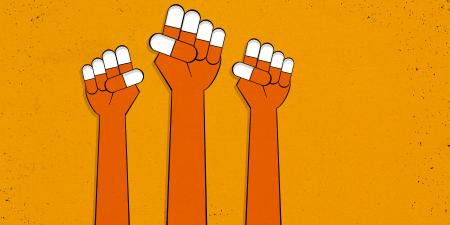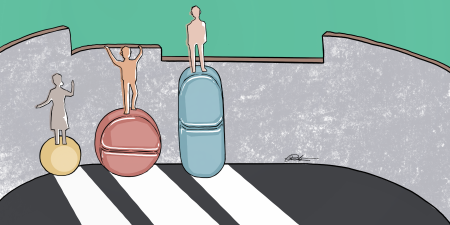Abstract
Responding to the public health crisis in the United States resulting from untreated opioid use disorder (OUD) requires expanding delivery of effective treatments, including medications, and eliminating stigma against people with OUD and people seeking OUD treatment. Stigma discourages people with substance use disorders from seeking care and compromises the care they receive when they do seek it. Stigma against both medication treatments for OUD and harm-reduction approaches like syringe services programs has created additional barriers to these strategies’ acceptance and use. It is ethically incumbent upon everyone in medicine and health care to recognize addiction not as a moral failing but as a treatable disease.
Opioid Use Disorder as a Public Health Crisis
The United States is in the midst of a public health crisis arising from untreated opioid use disorder (OUD) that is currently claiming 130 lives every day.1 Despite the existence of effective, potentially lifesaving treatment, far too few of the approximately 2 million people in the United States with OUD receive appropriate care.2 Thus, one of the cornerstones of current federal efforts to reverse the opioid crisis is greatly expanding the delivery of effective treatments, including medications for OUD (MOUD),3 while at the same time supporting the development of new therapeutics for OUD and overdoses.4
A major obstacle to these efforts is overwhelming stigma against people with OUD and other substance use disorders (SUDs).5Stigma stymies progress across the entire trajectory of prevention, treatment, and recovery. In caring for people with SUDs, health care professionals can unintentionally contribute to or perpetuate stigma. People with drug or alcohol use disorders—more than 20 million Americans2—are far too often judged, mistreated, and untreated by the very people who aim to help them and who, by regarding SUD not as a chronic illness but as a moral weakness, justify withholding care.6
Stigma Against People With SUD
Addiction is a medical disorder characterized by profound alterations in brain circuitry subjected to repeated substance exposure.7 More common in people with genetic, environmental, or developmental risk factors, these alterations affect reward processing, which is necessary to motivate and prioritize behaviors; executive function, which is necessary for self-regulation; and mood, which is necessary for well-being.8 Although progress has been made in understanding the root causes of addiction, many health care workers continue to endorse stigmatizing views of people with SUDs.9
The stigma of an addiction and the risks of losing a job or child custody can keep people with SUDs from seeking treatment.5 Without systematic screening, fear of stigma can lead to addiction going unidentified, since people are reluctant to reveal their substance use to their physicians.10And since nobody wants to think of themselves as being an “addict”—a label that is implicitly shaming and judging—people whose lives literally depend on treatment might not even acknowledge to themselves or their loved ones that they have a problem.
The obstacles to overcoming stigmatizing attitudes toward people with SUDs are great. People with SUDs might violate social norms in a way that alienates them even from their families and friends. They might lie or steal to support their drug problem11 and behave violently when undergoing withdrawal12 or while experiencing a drug-induced psychotic episode.13 As a result, people with SUDs can be judged harshly. Recognizing these obstacles, addressing stigma is an integral part of the 5-point strategy of the US Department of Health and Human Services (HHS) for addressing the opioid crisis. HHS, with which the authors are affiliated, is addressing stigma at multiple touchpoints—for instance, by encouraging drug courts as an alternative to incarceration and by identifying special challenges and solutions for people living in rural communities.14
Stigma Against SUD Treatment
For decades, the addiction treatment system in the United States has been largely separate from the rest of health care, and this reality both stems from and feeds stigma. Although MOUD is now recognized as the gold standard in the treatment of OUD,15 opioid treatment programs, which have offered methadone to people with OUD for decades, remain the only source of this effective medication.16 Unfortunately, they are often viewed by communities as potential settings of drug-related crime. The “not-in-my-backyard” problem is an example of stigma that continues to present a challenge not only to opioid treatment programs but also to other facilities trying to serve those with OUD. HSS’ current efforts to integrate behavioral health and primary care services are focused on increasing access to SUD treatment, especially in underserved and hard-hit communities.17
One way to promote integrated care is by addressing barriers to coordination. Regulations established to protect patient privacy—most notably, the Health Insurance Portability and Accountability Act (HIPAA) and the Code of Federal Regulations provisions for preserving confidentiality of records of patients with substance use disorders (42 CFR Part 2)—have had the unintended consequence of impeding appropriate data integration across care settings, prompting revisions to the latter.18 The Center of Excellence for Integrated Health Solutions, funded by the Substance Abuse and Mental Health Services Administration (SAMHSA) and operated by the National Council for Behavioral Health, is a resource to assist clinicians in accessing the data they need to tailor treatment interventions while preserving patients’ privacy.19
The approval in 2002 of a partial opioid agonist, buprenorphine, was a major step forward toward greater integration of addiction treatment with the rest of health care by allowing for the medication treatment of addiction in primary care.20 Buprenorphine can be prescribed by any waivered physician, physician assistant, or nurse practitioner and is available in an increasing number of misuse-resistant and extended-release formulations (implants, depot injections).16 Unfortunately, dose and duration limits imposed by insurers sometimes limit patient access.21 Extended-release naltrexone, an opioid antagonist that prevents opioids from activating receptors in the brain, requires only a once-a-month injection. It also can be prescribed by any qualified clinician, as it has no misuse liability and is not a scheduled substance.16 Every person with OUD is unique and their care—including choice of medication—should be tailored accordingly.
In 2019, the National Academies of Sciences, Engineering, and Medicine issued a report on MOUD. Its conclusion was powerfully worded, stating that buprenorphine, methadone, and naltrexone save lives and are effective in reducing illicit opioid use, reducing relapse, protecting from overdoses, promoting treatment engagement, reducing criminal involvement, and improving functioning.16 Moreover, these effects are evident in every subpopulation with OUD.16 Thus, we must recommit to addressing the barriers to treatment, including stigma and the shortage of clinicians capable of providing MOUD.16 SAMHSA has taken up this important challenge to train and empower more clinicians to prescribe MOUD.22 In parallel, the National Institutes of Health (NIH), through the NIH HEAL (Helping to End Addiction Long-termSM) Initiative, is supporting ongoing research to develop models of care and optimal ways to implement them.4
Separation of addiction treatment systems from the rest of health care in the United States both stems from and feeds stigma.
Understanding of the critical role of medications in treating OUD has been slow to permeate not only health care but also justice settings. As many as 65% of inmates have a SUD, but evidence-based treatment while incarcerated remains hard to come by.23 Although there are certainly practical barriers, lack of treatment also stems from the false belief that the use of agonists or partial agonists just substitutes one addiction for another.24 This misconception persists, despite existing evidence that providing MOUD to incarcerated people with OUD can have a multitude of benefits, including lower risk of overdose upon release.25,26
Furthermore, harm reduction measures such as syringe services programs (SSPs), which provide clean needles, HIV testing, and other services to people who inject drugs, have been shown to improve outcomes and do not encourage or increase drug use.27 For this reason, the Office of the Assistant Secretary for Health, the Office of the Surgeon General, and the Centers for Disease Control and Prevention have publicly supported comprehensive SSPs as a way to prevent the spread of infectious disease and connect people to care.28
Alleviating Stigma
Research shows that alleviating stigma related to behavioral health conditions, including SUDs, is challenging.29 Public education and improving literacy about the medical (rather than the moral) basis of mental illness might lessen the perception of blame and increase care seeking, although it is not clear whether these measures reduce stigmatizing attitudes. The most effective interventions for reducing stigma are those that increase contact between the affected population and the wider population.29 The more people directly relate to those with mental illness or addiction, the less likely it is that they will moralize, stigmatize, and discriminate against these individuals.
Widespread availability of treatment for SUDs in primary care and other health care settings like emergency departments will help reduce stigma around SUD by countering the assumption that it is a moral failing. HHS is leading unique initiatives that expand access to quality SUD treatment. States have been granted the flexibility to design demonstrations that improve access to high-quality, clinically appropriate treatment for Medicaid beneficiaries with SUD.30 Medicare coverage for OUD treatment services furnished by opioid treatment programs has now expanded.31 Through these advances, HHS is supporting the delivery of treatment and recovery services and thereby stigma reduction.
To increase access to care, we encourage physicians in various specialties, as well as nurse practitioners and physician assistants, to receive training in recognizing addiction and, when appropriate, referring patients to treatment or initiating treatment themselves. This training should qualify health professionals to become waivered prescribers of buprenorphine when possible.
Finally, to reduce stigma, health system policies must also ensure that all personnel preserve the dignity of patients with SUDs, beginning with communication standards that avoid stigmatizing language.32,33 Procedures should also be instituted to legally and financially protect those seeking and receiving appropriate SUD treatment, such as enforcing parity laws that require insurance companies to cover evidence-based substance use counseling and medications to the same extent that they cover treatments for any other chronic disease.
History repeatedly shows that progress is made in addressing a public health crisis when the condition is brought out of the shadows. It is ethically incumbent upon medical professionals and everyone across the health care system, including insurers, to treat people with SUDs with the same dignity and respect given to any other patient group. Making headway against the current opioid crisis depends on an attitudinal shift away from blame, shame, and stigma and toward respect and compassion.
References
-
US Department of Health and Human Services. What is the US opioid epidemic? https://www.hhs.gov/opioids/about-the-epidemic/index.html. Reviewed September 4, 2019. Accessed April 21, 2020.
-
Center for Behavioral Health Statistics and Quality, Substance Abuse and Mental Health Services Administration. Results From the 2018 National Survey on Drug Use and Health: Detailed Tables Prevalence Estimates, Standard Errors, P Values, and Sample Sizes. https://www.samhsa.gov/data/sites/default/files/cbhsq-reports/NSDUHDetailedTabs2018R2/NSDUHDetailedTabs2018.pdf. Published August 2019. Accessed March 27, 2020.
-
US Department of Health and Human Services. 5-point strategy to combat the opioid crisis. https://www.hhs.gov/opioids/about-the-epidemic/hhs-response/index.html. Reviewed August 7, 2018. Accessed February 20, 2020.
- Collins FS, Koroshetz WJ, Volkow ND. Helping to end addiction over the long-term: the research plan for the NIH HEAL initiative. JAMA. 2018;320(2):129-130.
-
Tsai AC, Kiang MV, Barnett ML, et al. Stigma as a fundamental hindrance to the United States opioid overdose crisis response. PLoS Med. 2019;16(11):e1002969.
- Brener L, von Hippel C, Horwitz R, Hamwood J. The impact of pluralistic ignorance on the provision of health care for people who inject drugs. J Health Psychol. 2015;20(9):1240-1249.
- Koob GF, Volkow ND. Neurocircuitry of addiction. Neuropsychopharmacology. 2010;35(1):217-238.
- Volkow ND, Koob GF, McLellan AT. Neurobiologic advances from the brain disease model of addiction. N Eng J Med. 2016;374(4):363-371.
-
Rivera AV, DeCuir J, Crawford ND, Amesty S, Lewis CF. Internalized stigma and sterile syringe use among people who inject drugs in New York City, 2010-2012. Drug Alcohol Depend. 2014;144:259-264.
-
McNeely J, Kumar PC, Rieckmann T, et al. Barriers and facilitators affecting the implementation of substance use screening in primary care clinics: a qualitative study of patients, providers, and staff. Addict Sci Clin Pract. 2018;13(1):8.
-
Bureau of Justice Statistics, US Department of Justice. Drugs and crime facts. https://www.bjs.gov/content/dcf/duc.cfm. Revised April 7, 2020. Accessed April 7, 2020.
-
Gilchrist G, Dennis F, Radcliffe P, Henderson J, Howard LM, Gadd D. The interplay between substance use and intimate partner violence perpetration: a meta-ethnography. Int J Drug Policy. 2019;65:8-23.
-
Zarrabi H, Khalkhali M, Hamidi A, Ahmadi R, Zavarmousavi M. Clinical features, course and treatment of methamphetamine-induced psychosis in psychiatric inpatients. BMC Psychiatry. 2016;16:44.
-
Office of National Drug Control Policy. Rural community action guide: building stronger, healthy, drug-free rural communities. https://www.usda.gov/sites/default/files/documents/rural-community-action-guide.pdf. Accessed February 20, 2020.
- Crotty K, Freedman KI, Kampman KM. Executive summary of the focused update of the ASAM National Practice Guideline for the Treatment of Opioid Use Disorder. J Addict Med. 2020;14(2):99-112.
-
National Academies of Sciences, Engineering, and Medicine. Medications for Opioid Use Disorder Save Lives. Washington, DC: National Academies Press; 2019.
-
Substance Abuse and Mental Health Services Administration. A quick start guide to behavioral health integration for safety-net primary care providers. https://www.thenationalcouncil.org/wp-content/uploads/2020/01/Website-Resources.pdf?daf=375ateTbd56. Accessed June 8, 2020.
-
Hu LL, Sparenborg S, Tai B. Privacy protection for patients with substance use problems. Subst Abuse Rehabil. 2011;2:227-233.
-
National Council of Behavioral Health. Center of Excellence for Integrated Health Solutions. https://www.thenationalcouncil.org/integrated-health-coe/. Accessed June 8, 2020.
-
Substance Abuse and Mental Health Services Administration. The SAMHSA Evaluation of the Impact of the DATA Waiver Program: summary report. https://www.samhsa.gov/sites/default/files/programs_campaigns/medication_assisted/evaluation-impact-data-waiver-program-summary.pdf. Published March 30, 2006. Accessed April 21, 2020.
-
Moran GE, Snyder CM, Noftsinger RF, Noda JK. Implementing medication-assisted treatment for opioid use disorder in rural primary care: environmental scan. Vol 1. AHRQ publication 17(18)-0050-EF 2017. Rockville, MD: Agency for Healthcare Research and Quality; 2017. https://integrationacademy.ahrq.gov/sites/default/files/mat_for_oud_environmental_scan_volume_1_1.pdf. Accessed June 9, 2020.
-
Substance Abuse and Mental Health Services Administration. Medication assisted treatment: training materials and resources. https://www.samhsa.gov/medication-assisted-treatment/training-materials-resources. Updated September 5, 2019. Accessed June 9, 2020.
-
National Center on Addiction and Substance Abuse, Columbia University. Behind Bars II: Substance Abuse and America’s Prison Population. https://files.eric.ed.gov/fulltext/ED509000.pdf. Published February 2010. Accessed June 9, 2020.
- Wakeman SE. Why it’s inappropriate not to treat incarcerated patients with opioid agonist therapy. AMA J Ethics. 2017;19(9):922-930.
- Green TC, Clarke J, Brinkley-Rubinstein L, et al. Postincarceration fatal overdoses after implementing medications for addiction treatment in a statewide correctional system. JAMA Psychiatry. 2018;75(4):405-407.
-
Brinkley-Rubinstein L, McKenzie M, Macmadu A, et al. A randomized, open label trial of methadone continuation versus forced withdrawal in a combined US prison and jail: findings at 12 months post-release. Drug Alcohol Depend. 2018;184:57-63.
-
Centers for Disease Control and Prevention. Summary of information on the safety and effectiveness of syringe services programs (SSPs). https://www.cdc.gov/ssp/syringe-services-programs-summary.html. Accessed June 9, 2020.
-
Centers for Disease Control and Prevention. CDC releases materials on syringe services programs. https://www.cdc.gov/nchhstp/dear_colleague/2019/dcl-052319-SSP.html. Published May 23, 2019. Accessed June 9, 2020.
-
Corrigan PW, Nieweglowski K. Stigma and the public health agenda for the opioid crisis in America. Int J Drug Policy. 2018;59:44-49.
-
Centers for Medicare and Medicaid Services. 1115 Substance use disorder demonstrations. https://www.medicaid.gov/resources-for-states/innovation-accelerator-program/program-areas/substance-use-disorders/1115-substance-use-disorder-demonstrations/index.html. Accessed April 7, 2020.
-
Centers for Medicare and Medicaid Services. Opioid treatment programs (OPTs) Medicare billing and payment fact sheet. https://www.cms.gov/files/document/otp-billing-and-payment-fact-sheet.pdf. Accessed April 7, 2020.
-
Botticelli M. Stigma and substance use disorder: breaking down barriers to treatment and sound public policy. HealthCity. May 23, 2019. https://www.bmc.org/healthcity/policy-and-industry/stigma-barrier-to-sud-treatment-public-policy. Accessed February 20, 2020.
- Kelly JF, Westerhoff CM. Does it matter how we refer to individuals with substance-related conditions? A randomized study of two commonly used terms. Int J Drug Policy. 2010;21(3):202-207.



